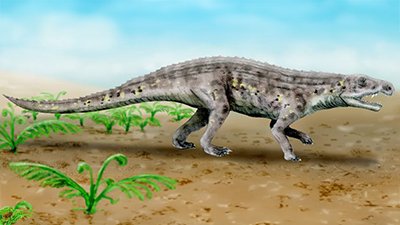
Dinosaur Clones
“Dinosaur Encore”? Harvard physicist thinks dino-clones are around the corner.
News Source
Could modern science resurrect dinosaurs? (Real ones, not the pretend ones on your birdbath.) In a recent video posted by Big Think, Harvard theoretical physicist Michio Kaku speculates with a resounding yes. His ideas represent a mixture of actual experimental science and evolutionary assumptions. And while he cites the documented discoveries of soft tissue in dinosaurs to support his premise, evolutionist Brian Switek finds Kaku’s acceptance of those discoveries to be his most objectionable point.
Kaku begins by pointing out that present technology has been able to clone animals from carcasses.
Kaku begins by pointing out that present technology has been able to clone animals from carcasses. Not only steak lovers1 but also dog lovers have benefited, as the sweet story of the cloned Labrador “Lancelot Encore” illustrates.2 Then Kaku reminds us that the Neanderthal genome has been sequenced—also true. And he reminds us that while ongoing efforts to clone mammoths could only produce furry elephants, any effort to clone a Neanderthal would produce a moral dilemma. The problem of how to treat such a person is the dilemma he mentions. An additional problem—destroying human embryos as a necessary step in such an effort—is another.
Kaku’s train of wishful thinking veers into difficulty at this point. He rightly points out that soft tissue has been recovered from dinosaur fossils. And he points out that proteins, not DNA, have been found in some of those materials. Each protein is blueprinted by a gene, a tiny fraction of an organism’s DNA. Therefore, it is not possible to “back-calculate” or “reverse engineer” an entire genome from protein samples. No DNA, no clone. But no problem, Kaku thinks.
Enter the chicken and the werewolf. The proteins found in the soft tissue of these dinosaur fossils are similar to those in frogs, reptiles, and even chickens. Kaku interprets this as proof that dinosaurs “biochemically are very closely related to birds.”
Biochemical similarity, however, does not demonstrate evolutionary ancestry. Many proteins show up in multiple creatures, and as a result their DNA blueprints sometimes appear to have been cut-and-pasted throughout the living creatures of the world. Yet this similarity is completely consistent with the testimony of biblical history: God is the common Designer. Why should we think He would have invented a whole new kind of biochemistry for each kind of creature? Since all living things needed to share the same world, the basic biochemistry of all living things needed to fit. Like most evolutionists, Kaku thinks the fact that a gene that shows up in multiple creatures is evidence of common evolutionary ancestry rather than simply common design.
Kaku then points to the epigenetic regulation involved in switching genes on and off. “Nature does not simply throw away good genes. Nature simply turns them off,” he says. Epigenetics involves chemical changes that affect whether a gene is expressed not.
Mutations involve a loss of information, as in this loss of proper genetic regulation, but such a de-regulation does not unveil an “ancient” ape-like ancestor’s gene.
To support this idea—that genes are just switched on and off to build new kinds of creatures—he states, “We have the genes in our own body that would put hair all over our body and you can actually turn that gene on and create, quote, unquote, a werewolf. In fact, in Mexico City there are two young boys with hair all over their bodies that are acrobats in a circus and scientists have sequenced the genes and yes, it is a very ancient gene that they have.” Kaku is talking about an X-linked dominant condition called congenital generalized hypertrichosis, found to affect 19 members of a Mexican family. Despite the investigators’ statement, “A back mutation is postulated as the origin of this new phenotype,”3 the phrase “back mutation” is based on the unproven and unprovable assumption that humans evolved from ape-like ancestors. Mutations involve a loss of information, as in this loss of proper genetic regulation, but such a de-regulation does not unveil an “ancient” ape-like ancestor’s gene.
Kaku hopes that a combination of all this wonderful technology can be stirred up by supercomputers to spit out “the best fit for a reptile that is like a dinosaur, insert that perhaps, into the womb of maybe an alligator or a whatever and perhaps give birth to an egg, which will hatch something resembling a dinosaur.”
In “Where’s My Clone-o-saurus?” Smithsonian Magazine writer Brian Switek bemoans Kaku’s optimistic oversimplification of the techniques that would be required to clone a dinosaur. But he also takes great issue with Kaku’s dependence on reports of preserved soft tissue and biomolecules in dinosaurs.4 He discounts Mary Schweitzer’s discovery of apparent blood vessels, red blood cells, and intact proteins inside dinosaur bone, writing her discovery off as a bacterial biofilm. Reading the comments to Switek’s article reads like a bibliography as his evolutionary readers have shared numerous articles documenting the validity of the biological remains of dinosaurs and refuting the biofilm theory. Last year Schweitzer participated in more research confirming the preservation of authentic collagen.
We, who understand from Scripture’s eyewitness account of our history that the earth is only about 6,000 years old, do not find it so shocking that some biological material is still present in some dinosaur fossils, which were entombed by the same catastrophe that buried most other fossilized animals—the global Flood.
The problem with Kaku’s presumptions, however, is the presumption that an evolutionary extrapolation could produce the blueprint for a dinosaur near-clone. If the genome of a dinosaur is ever sequenced from soft tissue in a fossil, then we’ll know something about dinosaur DNA. But if a computer simply extrapolates, on the basis of evolutionary assumptions about chickens, what dinosaur DNA should have looked like, then we will really know nothing about dinosaur DNA.
Further Reading
- Two: Those Not-So-Dry Bones
- Collagen Coils
- Jurassic Spark?
- News to Note, December 31, 2011: Year in Review
- Scientists Rewind Evolution With Unique Chicken Embryo
- Jurassic Rat Now Considered Oldest Mammalian Ancestor
- 3D Film "Flying Monsters" Wins BAFTA Award
- Jurassic Prank
For More Information: Get Answers
Remember, if you see a news story that might merit some attention, let us know about it! (Note: if the story originates from the Associated Press, FOX News, MSNBC, the New York Times, or another major national media outlet, we will most likely have already heard about it.) And thanks to all of our readers who have submitted great news tips to us. If you didn’t catch all the latest News to Know, why not take a look to see what you’ve missed?
(Please note that links will take you directly to the source. Answers in Genesis is not responsible for content on the websites to which we refer. For more information, please see our Privacy Policy.)
Footnotes
- P. Ghosh, “Cattle ‘Cloned from Dead Animals’,” BBC News, August 12, 2010, http://www.bbc.com/news/science-environment-10951108.
- M. Inbar, TODAY, January 28, 2009, http://today.msnbc.msn.com/id/28892792/ns/today-today_pets_and_animals/t/couple-spend-clone-dead-dog.
- M. A. Macías-Flores, D. García-Cruz, H. Rivera, M. Escobar-Luján, A. Melendrez-Vega, D. Rivas-Campos, F. Rodríguez-Collazo, I. Moreno-Arellano and J. M. Cantu, “A New Form of Hypertrichosis Inherited as an X-linked Dominant Trait.” Human Genetics 66 (1984): 66–70. doi:10.1007/BF00275189. See also E. Mitchell, “Human Hairs Developed to Beat Back Bugs,” Answers in Genesis, December 24, 2011, https://answersingenesis.org/human-evolution/origins/human-hairs-developed-to-beat-back-bugs/.
- B. Switek, “Where’s My Clone-o-saurus?,” Smithsonian, September 27, 2012, http://www.smithsonianmag.com/science-nature/wheres-my-clone-o-saurus-52212115/.
Recommended Resources

Answers in Genesis is an apologetics ministry, dedicated to helping Christians defend their faith and proclaim the good news of Jesus Christ.
- Customer Service 800.778.3390
- © 2024 Answers in Genesis







